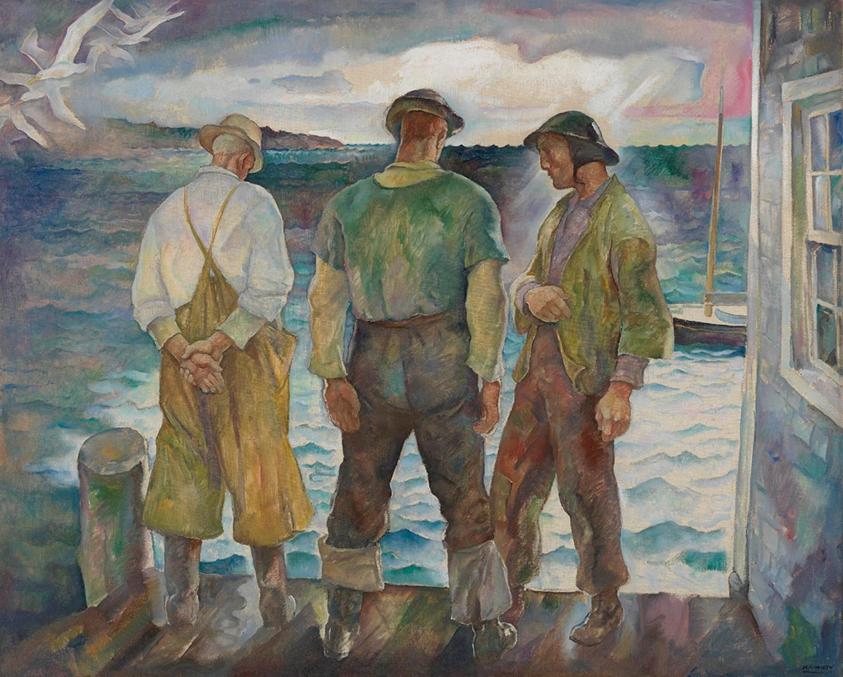
Artist:
N.C. Wyeth
(American, 1882 - 1945)
Three Fishermen
Medium: Oil on canvas
Date: ca. 1934
Dimensions:
42 1/4 × 52 1/4 in. (107.3 × 132.7 cm)
Brandywine Museum of Art, Bequest of Carolyn Wyeth, 1996
Accession number: 96.1.39
Label Copy:
N. C. Wyeth’s painting of three fisherman set against the backdrop of the sea has been compared to the Maine work of both Rockwell Kent (1882-1971) and Marsden Hartley (1877-1943). The broad and solid masses of the fishermen themselves, with their feet planted firmly on the dock, lend an air of monumentality to the figures. Their triangular forms rise up against their environment, culminating in their heads, which Wyeth placed directly on the horizon. This composition of Three Fishermen stayed with Wyeth, who painted another version of it in 1938, with only minor changes.
Research Number: NCW: 590
InscribedLower right: N C WYETH (underlined)
ProvenanceN. C. Wyeth; Mrs. N. C. Wyeth; Carolyn Wyeth
Exhibition History(exhibited in Philadelphia in 1934, according to note in NCW's hand on reverse of archival photograph); Washington, D. C., 1935, no. 11, illus. b/w p. 116; New York, NY, City of New York Municipal Art Committee (International Building, Rockefeller Center), "First National Exhibition of American Art," May 18 - July 1, 1936, no. 161, as "Three Fishermen"; Chadds Ford, PA, 1995, no. 20, illus. b/w p. 20; Chadds Ford, PA, 2003
References
Richard Layton, "Inventory of Paintings in the Wyeth Studio, 1950, " unpublished, Wyeth Family Archives, p. 77; Mary Edith Hinshaw, diary notation, summer 1934 (unpublished but excerpted in "The Window," publication of W. H. Moring, Jr., Arts Center, Asheboro, NC, vol. 1, issue 4 (Fall 1997); Christine B. Podmaniczky, N. C. Wyeth, Catalogue Raisonne of Paintings (London: Scala, 2008), P.45, p. 820-821; Christine B. Podmaniczky, "N. C. Wyeth, American Regionalist" in Rural Modern, American Art Beyond the City (NY: Rizzoli, 2016), p. 167, illus. in color, p. 166;
Curatorial RemarksSome of Wyeth's Maine paintings reflect the influence of Rockwell Kent, an exact contemporary. The two probably met because Kent was a member of the jury at the 121st annual exhibition of the Pennsylvania Academy of the Fine Arts (1926) that awarded Wyeth a prize. Wyeth owned a copy of Rockwellkentiana, an important early catalogue of Kent's work.
Wyeth and Kent shared a number of important principles. Both men felt the fundamental basis for art was experience and both found inspiration in the writings of Henry David Thoreau. Both were influenced by art critic Christian Brinton, a part-time resident of West Chester, Pennsylvania. Between 1925 and 1935, Wyeth experimented with modernist techniques and styles, work which suggests he had looked closely at Brinton's collection of Soviet graphic art. Andrew Wyeth recalled that his father particularly admired Kent's Maine paintings from the Monhegan period (1905-1910), and in paintings like this one the vaguely geometric shapes and heroic statures of the figures are similar to those in Kent's work and to the solid, clean forms found in Soviet art. For both Wyeth and Kent, the powerful figure of the ordinary fisherman symbolized the ideal of a life fully integrated with the natural environment.
Wyeth considered this painting so successful that in 1938 he repainted the image on a panel with minor changes (see NCW 589).
Wyeth and Kent shared a number of important principles. Both men felt the fundamental basis for art was experience and both found inspiration in the writings of Henry David Thoreau. Both were influenced by art critic Christian Brinton, a part-time resident of West Chester, Pennsylvania. Between 1925 and 1935, Wyeth experimented with modernist techniques and styles, work which suggests he had looked closely at Brinton's collection of Soviet graphic art. Andrew Wyeth recalled that his father particularly admired Kent's Maine paintings from the Monhegan period (1905-1910), and in paintings like this one the vaguely geometric shapes and heroic statures of the figures are similar to those in Kent's work and to the solid, clean forms found in Soviet art. For both Wyeth and Kent, the powerful figure of the ordinary fisherman symbolized the ideal of a life fully integrated with the natural environment.
Wyeth considered this painting so successful that in 1938 he repainted the image on a panel with minor changes (see NCW 589).
Image Source for printed Catalogue Raisonne:transparency directly from painting
On view